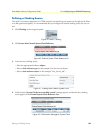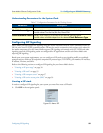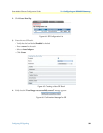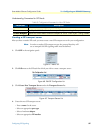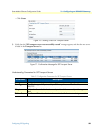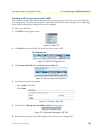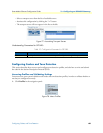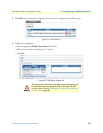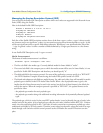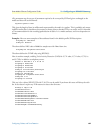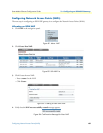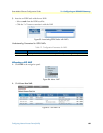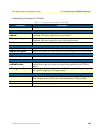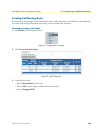
Configuring Codecs and Tone Detection 62
Smart Media Software Configuration Guide 3 • Configuring an ISDN-SIP Gateway
Managing the Session Description Protocol (SDP)
You can specify the Profile SDP Description to define which voice codecs are supported in the Network Access
Po
int (NAP) using this Profile.
Here is the default Profile SDP Description:
m=audio 0 RTP/AVP 0 8 4 96 97 18 98 13
a=rtpmap:96 iLBC/8000
a=rtpmap:97 iLBC/8000
a=fmtp:97 mode=20
a=rtpmap:98 telephone-event/8000
Each line of the Profile SDP Description consists of text of the form <type>=<value>. <type> is always exactly
one character and is case-significant. <value> is a structured text string whose format depends on <type>. It also
will be case-significant unless a specific field defines otherwise. Whitespace is not permitted either side of the
`=' sign. In general <value> is either a number of fields delimited by a single space character or a free format
string.
In our Profile SDP Description, only 2 <type> are used.
Media Announcement
The format of media announcement is as follows:
m=<media> <port> <transport> <fmt list>
• The first sub-field is the media type. Currently defined media for Smart Media is "audio".
• T
he second sub-field is the transport port to which the media stream will be sent. In Smart Media, it is not
specified in Profile SDP Description and therefore you should specify "0".
• T
he third sub-field is the transport protocol. For most of the application, you may specify it as "RTP/AVP"
- the IETF's Realtime Transport Protocol using the Audio/Video profile carried over UDP.
• T
he fourth and subsequent sub-fields are media formats. For audio and video, these will normally be media
payload types as defined in the RTP Audio/Video Profile. When a list of payload formats is given, this
implies that all of these formats may be used in the session, but the first of these formats is the default for-
mat for the session. When the transport protocol is specified as "RTP/AVP", the payload format can be
s
pecified as either
- the payload type number for static payload types
-
the payload type number along with additional encoding information for dynamically allocated payload
types.
The payload type, which is carried in the actual RTP packet head
er, is used to identify the type of codec infor-
mation carried in the packet. A list of payload type values for each codec is defined within RFC3551. Unfortu-
nately, since the payload type field is only 7 bits-wide, all
codecs cannot have a permanent payload type value
understood universally by all VoIp systems. Therefore, some codecs have dynamic values that need to be nego-
tiated through a call control or session control protocol
such as SIP before the actual RTP session can take
place.



